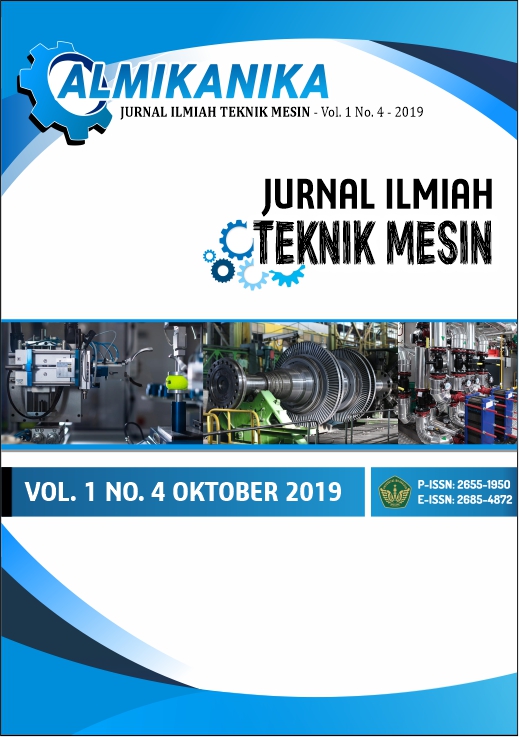PEMANFAATAN SERAT SABUT KELAPA SEBAGAI MATERIAL PENGGANTI ABS PADA KOMPOSIT RESIN POLYESTER UNTUK APLIKASI FRAME DRONE
DOI:
https://doi.org/10.32832/almikanika.v1i4.5195Abstract
ABSTRACT
Modern technology in drone frame construction materials is required to be able to find materials that are lightweight but have high durability (strength). Materials with this character have many benefits, especially as the main material for the drone frame body. In this study, the mechanical characteristics of coconut fiber composites with variations in fiber direction are described which aims to determine the tensile strength, strain, fracture strength and ductility values by utilizing waste material from coconuts. The first step in making this coconut fiber reinforced composite is using a glass mold measuring 30 x 20 x 0.5cm. The coconut fiber used as a reinforcement for this composite uses Yukalac 235 brand resin with polyester resin type 157 BTQN-EX and Methyl Etyl Ketone Peroxide (MEKPO) catalyst. The ratio between matrix and fiber is 85%: 15% and 70%: 30%. Standard specimens using ASTM D3039 except for the thickness of the specimen. The test was carried out 5 times from the variations, namely matrix, parallel fiber direction composite and cross fiber direction composite. Composite testing was carried out at the Lipi Cibinong Biomaterials Laboratory. Based on the results of the study, it can be concluded that the tensile strength of the matrix is 30.30 MPa and the strain is 2.35%. Meanwhile, 15% parallel fiber has a tensile strength of 29.46 MPa and a strain of 2.36% and 30% parallel fiber has a tensile strength of 30.31 MPa and a strain of 2.38% which is almost the same as the matrix. Composites with cross fiber direction variation have the lowest tensile strength value with 15% cross fiber which is only 26.04 MPa and the strain is 2.29% and 30% cross fiber has a tensile strength value of 27.17 MPa and the strain is 2.31%. The greatest tensile strength and strain occur in composites with variations in the direction of parallel fibers. On the other hand, the use of coconut fiber can be used as an environmentally friendly composite material for drone frames.
References
DAFTAR PUSTAKA
R. Mahardika, "PEMANFAATAN SERABUT KELAPA SEBAGAI BAHAN DASAR PEMBUATAN SOFA DENGAN METODE ADHESIVE GUNA PEMANFAATAN MEDIA ONLINE SEBAGAI STRATEGI PEMASARAN PRODUK Abstrak,” no. September, 2017.
M. A. Serikat and P. Av-, "KOMPOSIT,” 1985.
Wicaksono, "Pengaruh Penggunaan Fender-Frame- Drone dan Beban Terhadap Konsumsi Arus Baterai,” Skripsi. Univ. Negeri Semarang, 2019.
I. Mujiarto, "Sifat dan Karakteristik Material Plastik dan Bahan Aditif,” Traksi, vol. 3, no. 2, pp. 65–74, 2005.
L. Diana, A. G. Safitra, and M. N. Ariansyah, "Analisis Kekuatan Tarik pada Material Komposit dengan Serat Penguat Polimer,” vol. 4, no. 2, pp. 59–67, 2020.
L. Kristianto, "Pengaruh Persentase Serat Fiberglass Terhadap Kekuatan Tarik Komposit Polimer Polyester,” p. 94, 2018, [Online]. Available: http://repository.usd.ac.id/31355/2/145214026_full.pdf.
P. Mallick, Fiber-Reinforced Composites:Materials,Manufacturing, And Design, vol. 2. 2007.















